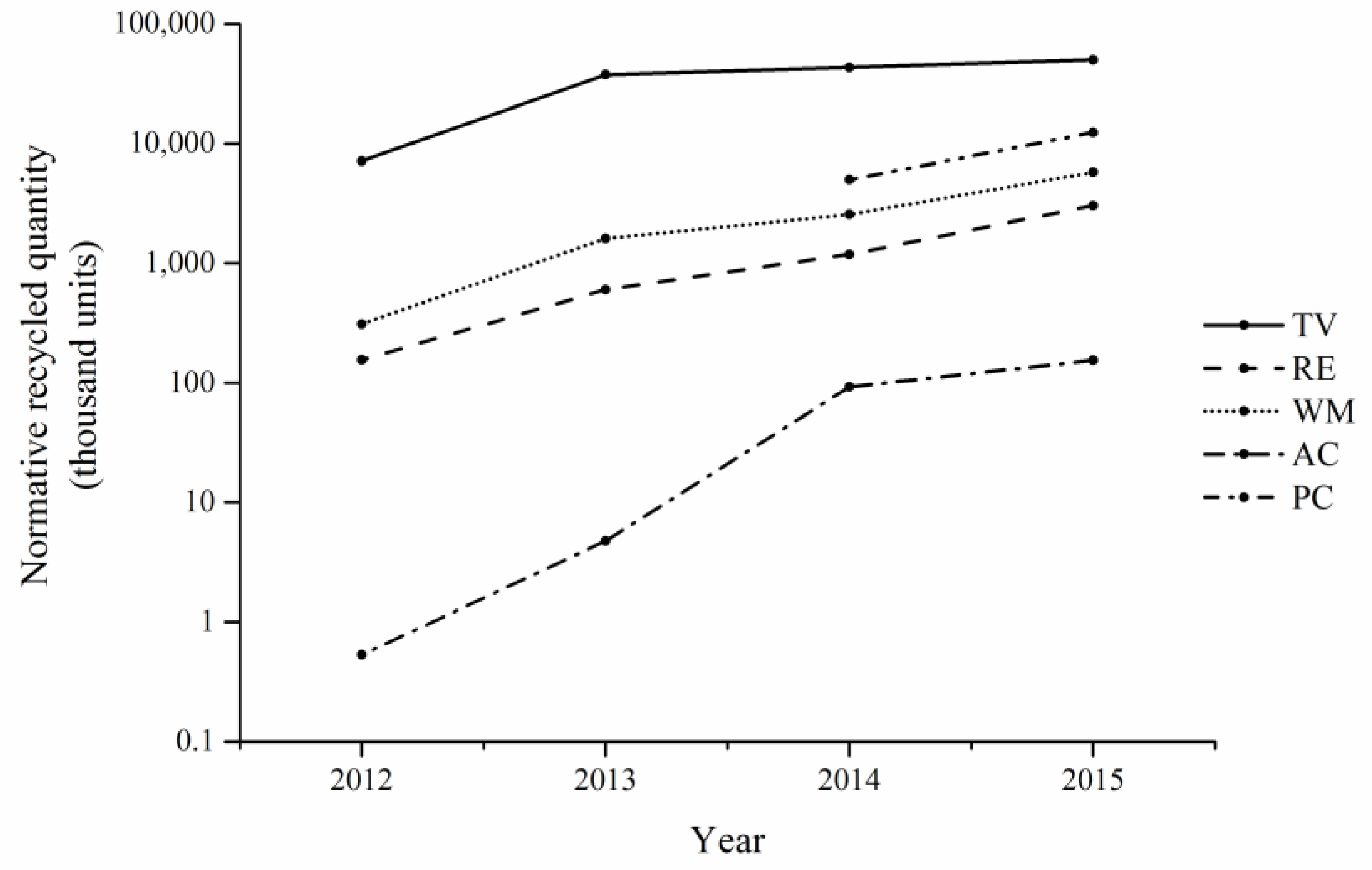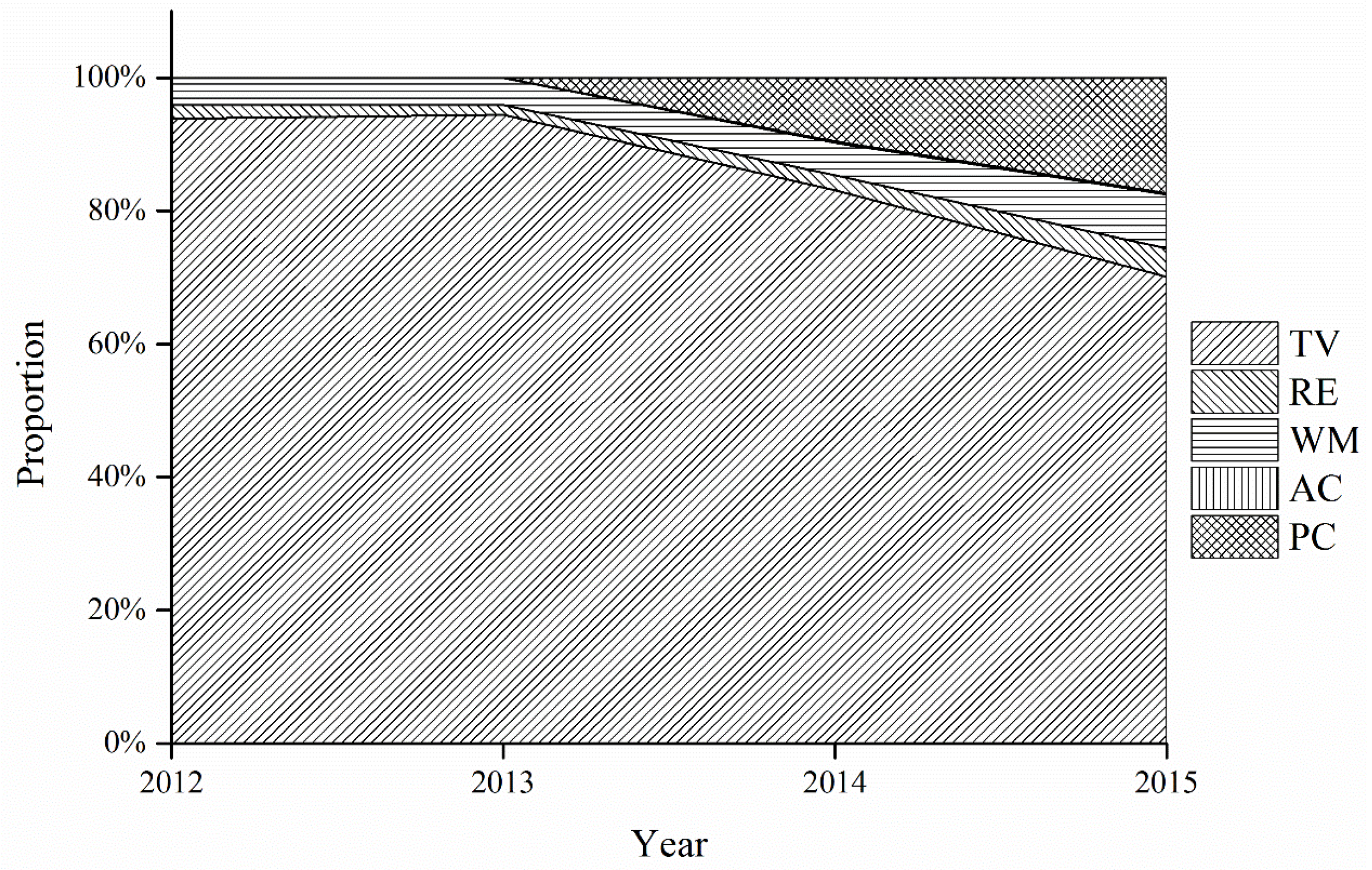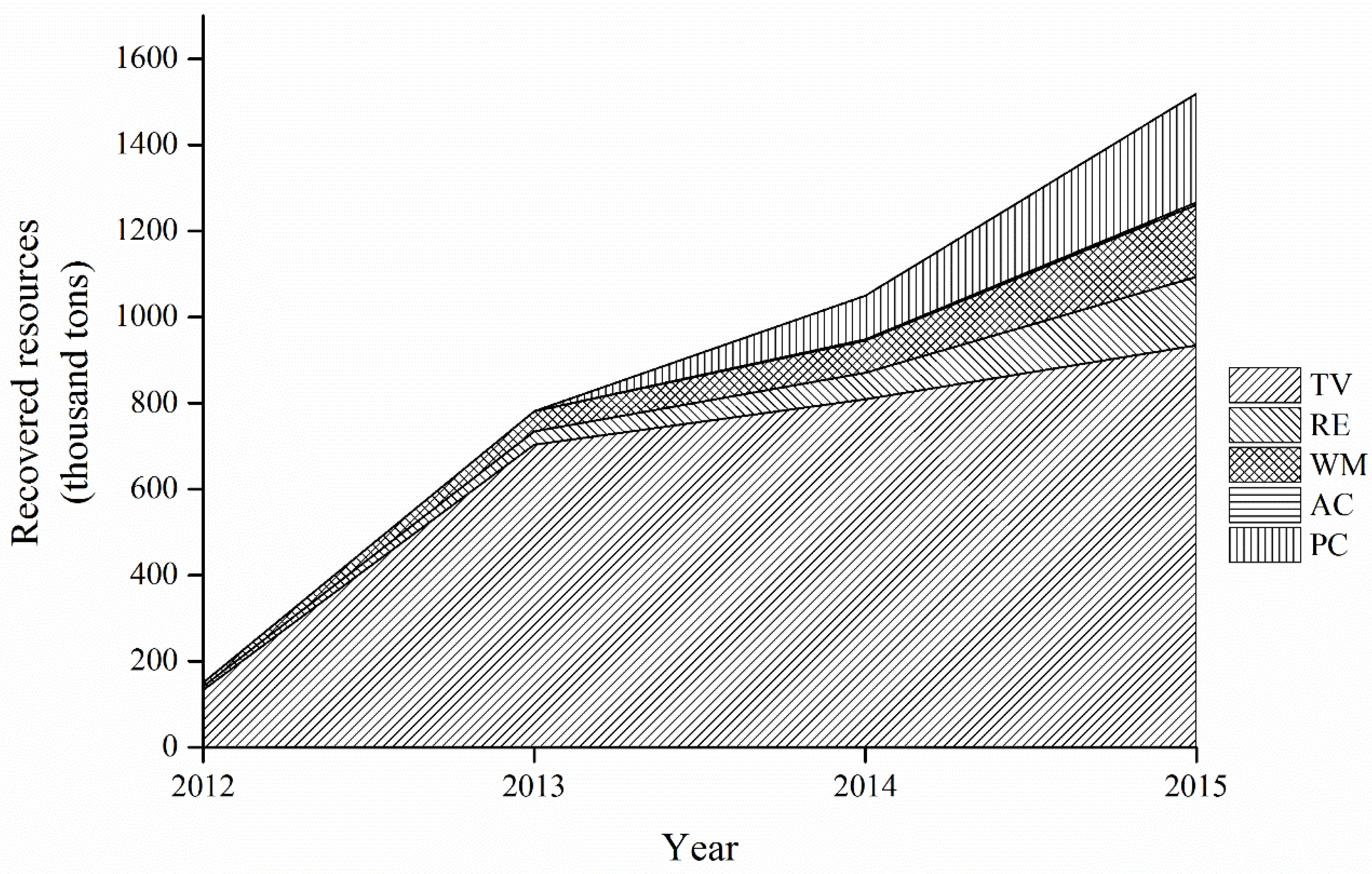An Effectiveness Assessment of China’s WEEE Treatment Fund
Abstract
:1. Introduction
2. Methods
2.1. Indicator Development
2.2. Indicator Explanations and Data Sources
2.2.1. Computational Methods
2.2.2. Estimation of Total Quantity of WEEE
2.2.3. Estimation of the Environmental Impact
3. Results and Discussion
3.1. Processing Aspect
3.1.1. Collection Target
3.1.2. Treatment Target
3.2. Performance Aspect
3.2.1. Resource Efficiency
3.2.2. Environmental Performance
4. Conclusions
Supplementary Materials
Author Contributions
Acknowledgments
Conflicts of Interest
References
- Zhou, H.C. Turning Trash into Treasure: China’s WEEE Recycling Industry and Policies Research; Science Press: Beijing, China, 2008; pp. 1–20. ISBN 9787030210296. [Google Scholar]
- Zeng, X.L.; Wang, F.; Li, J.; Gong, R. A simplified method to evaluate the recycling potential of e-waste. J. Clean. Prod. 2017, 168, 1518–1524. [Google Scholar] [CrossRef]
- Zhu, X.; Wang, J.; Tang, J. Recycling Pricing and Coordination of WEEE Dual-Channel Closed-Loop Supply Chain Considering Consumers’ Bargaining. Int. J. Environ. Res. Public Health 2017, 14, 1578. [Google Scholar] [CrossRef] [PubMed]
- Lindhqvist, T. Extended Producer Responsibility in Cleaner Production: Policy Principle to Promote Environmental Improvements of Product Systems. Ph.D. Thesis, Lund University, Lund, Sweden, 2000. [Google Scholar]
- Zeng, X.; Yang, C.; Chiang, J.F.; Li, J. Innovating e-waste management: From macroscopic to microscopic scales. Sci. Total Environ. 2017, 575, 1–5. [Google Scholar] [CrossRef] [PubMed]
- Daum, K.; Stoler, J.; Grant, R.J. Toward a More Sustainable Trajectory for E-Waste Policy: A Review of a Decade of E-Waste Research in Accra, Ghana. Int. J. Environ. Res. Public Health 2017, 14, 135. [Google Scholar] [CrossRef] [PubMed]
- Sthiannopkao, S.; Wong, M.H. Handling e-waste in developed and developing countries: Initiatives, practices, and consequences. Sci. Total Environ. 2013, 463–464, 1147. [Google Scholar] [CrossRef] [PubMed]
- Tong, X. Present State on the Utilization of Electronic Waste Materials and Its Development. Sci. Technol. Rev. 2002, 20, 59–61. [Google Scholar]
- Chi, X.; Streicher-Porte, M.; Wang, M.Y.; Reuter, M.A. Informal electronic waste recycling: A sector review with special focus on China. Waste Manag. 2011, 31, 731–742. [Google Scholar] [CrossRef] [PubMed]
- Orlins, S.; Guan, D. China’s toxic informal e-waste recycling: Local approaches to a global environmental problem. J. Clean. Prod. 2016, 114, 71–80. [Google Scholar] [CrossRef]
- Hong, J.; Shi, W.; Wang, Y.; Chen, W.; Li, X. Life cycle assessment of electronic waste treatment. Waste Manag. 2015, 38, 357–365. [Google Scholar] [CrossRef] [PubMed]
- Wang, F.; Kuehr, R.; Ahlquist, D.; Li, J. E-Waste in China: A Country Report; United Nations University: Bonn, Germany, 2013. [Google Scholar]
- Gu, Y.; Wu, Y.; Xu, M.; Wang, H.; Zuo, T. The stability and profitability of the informal WEEE collector in developing countries: A case study of China. Resour. Conserv. Recycl. 2016, 107, 18–26. [Google Scholar] [CrossRef]
- Zeng, X.; Duan, H.; Wang, F.; Li, J. Examining environmental management of e-waste: China’s experience and lessons. Renew. Sustain. Energy Rev. 2016, 72, 1076–1082. [Google Scholar] [CrossRef]
- Curran, M.A. Life cycle assessment: An international experience. Environ. Prog. 2004, 19, 65–71. [Google Scholar] [CrossRef]
- Yang, J.X. Methodology and Application of Life Cycle Assessment; China Meteorological Press: Beijing, China, 2002; pp. 1–50. ISBN 9787502933487.
- Yang, J.X. Toward a Product-orientated Environmental Management: Life Cycle Assessment. Environ. Sci. 1999, 20, 100–103. [Google Scholar]
- Chung, S.S. Projection of waste quantities: The case of e-waste of the People’s Republic of China. Waste Manag. Res. 2012, 30, 1130–1137. [Google Scholar] [CrossRef] [PubMed]
- Wilkinson, S.; Duffy, N. Waste Electrical and Electronic Equipment (WEEE) Collection Trials in Ireland; Environmental Protection Agency: Washington, DC, USA, 2003.
- Chancerel, P. Substance Flow Analysis of the Recycling of Small Waste Electrical and Electronic Equipment—An Assessment of the Recovery of Gold and Palladium. Ph.D. Dissertation, Technical University of Berlin, Berlin, Germany, 2010. [Google Scholar]
- Gao, Y.N.; Xu, H.; Lu, X.J. Estimating generation of obsolete mobile phones based on the market supply A method. In Proceedings of the 2010 Annual Conference of Chinese Society for Environmental Sciences, Shanghai, China, 5–7 May 2010. [Google Scholar]
- Polák, M.; Drápalová, L. Estimation of end of life mobile phones generation: The case study of the Czech Republic. Waste Manag. 2012, 32, 1583–1591. [Google Scholar] [CrossRef] [PubMed]
- Kumar, P.; Shrihari, S. Estimation and Material Flow Analysis of Waste Electrical and Electronic Equipment (WEEE)—A Case Study of Mangalore City, Karnataka, India. In Proceedings of the International Conference on Sustainable Solid Waste Management, Chennai, India, 5–7 September 2007. [Google Scholar]
- Song, Q.B.; Li, J.H.; Liu, L.L.; Dong, Q.Y.; Yang, J.; Liang, Y.Y.; Zhang, C. Measuring the generation and management status of waste office equipment in China: A case study of waste printers. J. Clean. Prod. 2016, 112, 4461–4468. [Google Scholar] [CrossRef]
- Wang, F.; Huisman, J.; Stevels, A.; Balde, C.P. Enhancing e-waste estimates: Improving data quality by multivariate Input-Output Analysis. Waste Manag. 2013, 33, 2397–2407. [Google Scholar] [CrossRef] [PubMed]
- Liu, X.; Tanaka, M.; Matsui, Y. Generation amount prediction and material flow analysis of electronic waste: A case study in Beijing, China. Waste Manag. Res. 2006, 24, 434–445. [Google Scholar] [CrossRef] [PubMed]
- Li, J.H.; Wen, X.F. Waste Electrical and Electronic Equipments Treatment Technologies; China Environmental Science Press: Beijing, China, 2006; pp. 1–192. ISBN 9787802092495. [Google Scholar]
- Guo, X.; Meng, W.; Ji, Y.J. Estimation of Electrical and Electronic Equipment Waste Generation Using a Modified Logistic Model in Tianjin City. Environ. Sci. Technol. 2014, 37, 188–193. [Google Scholar]
- Liang, X.; Li, G.; Huang, J.; He, W.; Ding, J. Estimation of waste electrical and electronic equipment (WEEE) generation and establishment of a recovery network in Shanghai. Acta Sci. Circumstantiae 2010, 30, 1115–1120. [Google Scholar]
- Liu, Z.; Zhang, Y.; Huang, H.; Xue, Y.; Wang, L. Prediction model for quantity of discarded household appliances and case in Anhui Province. Chin. J. Environ. Eng. 2016, 10, 317–322. [Google Scholar]
- Zhang, W.; Jiang, H.Q.; Wang, J.N.; Lu, Y.L. Amount of Electronic Waste Generated in China: Prediction and Characteristics Analysis. Environ. Sci. Technol. 2013, 36, 195–199. [Google Scholar]
- CHEARI. White Paper on WEEE Recycling Industry in China 2013; CHEARI: Beijing, China, 2014; pp. 10–16. [Google Scholar]
- Sun, X.; Liu, J.R.; Yang, D.; Lu, B. The carbon footprint of household air-conditioner and its key influence factors. Acta Sci. Circumstantiae 2014, 34, 1054–1060. [Google Scholar]
- Li, H. Research on the System of Recovery and Disposal and Economy of Recovery about Refrigeratory. Master’s Thesis, Hefei University of Technology, Hefei, China, 2007. [Google Scholar]
- Wang, S.T. Analysis of the Products for Thermal Treatment of Waste Electrical and Electronic Equipment. Master’s Thesis, Southwest Jiaotong University, Chengdu, China, 2009. [Google Scholar]
- Cheng, G.S.; Li, J.H.; Liu, L.L. Recycling process and metabolic rule of electronic waste. China Environ. Sci. 2010, 30, 658–665. [Google Scholar]
- Chi, X.; Wang, M.Y.L.; Reuter, M.A. E-waste collection channels and household recycling behaviors in Taizhou of China. J. Clean. Prod. 2014, 80, 87–95. [Google Scholar] [CrossRef]
- Song, Q.; Li, J. A systematic review of the human body burden of e-waste exposure in China. Environ. Int. 2014, 68, 82–93. [Google Scholar] [CrossRef] [PubMed]
- Song, Q.; Li, J.; Zeng, X. Minimizing the increasing solid waste through zero waste strategy. J. Clean. Prod. 2015, 104, 199–210. [Google Scholar] [CrossRef]
- Wang, F.; Huisman, J.; Meskers, C.E.M.; Schluep, M.; Stevels, A.; Hageluken, C. The Best-of-2-Worlds philosophy: Developing local dismantling and global infrastructure network for sustainable e-waste treatment in emerging economies. Waste Manag. 2012, 32, 2134–2146. [Google Scholar] [CrossRef] [PubMed]
- Prasara-A, J.; Grant, T. Comparative life cycle assessment of uses of rice husk for energy purposes. Int. J. Life Cycle Assess. 2011, 16, 493–502. [Google Scholar] [CrossRef]
- Belboom, S.; Renzoni, R.; Verjans, B.; Leonard, A.; Germain, A. A life cycle assessment of injectable drug primary packaging: Comparing the traditional process in glass vials with the closed vial technology (polymer vials). Int. J. Life Cycle Assess. 2011, 16, 159–167. [Google Scholar] [CrossRef]
- Jones, C.I.; Mcmanus, M.C. Life-cycle assessment of 11 kV electrical overhead lines and underground cables. J. Clean. Prod. 2010, 18, 1464–1477. [Google Scholar] [CrossRef]
- Suer, P.; Anderssonsköld, Y. Biofuel or excavation?-Life cycle assessment (LCA) of soil remediation options. Biomass Bioenergy 2011, 35, 969–981. [Google Scholar] [CrossRef]
- NDRC. Waste Electrical and Electronic Products Recycling Directory (2013) Evaluation and Adjustment Research; Social Sciences Academic Press (CHINA): Beijing, China, 2015; p. 15. ISBN 9787509762516.







| Category | Surcharge Rate | Subsidy Rate | ||
|---|---|---|---|---|
| Old | New | |||
| TV | 14 inches ≤ Size < 25 inches | 13 | 85 | 60 |
| Size ≥ 25 inches | 70 | |||
| RE | 50 L ≤ Volume ≤ 500 L | 12 | 80 | 80 |
| WM | Single-tub, Dryer (3 kg < Capacity ≤ 10 kg) | 7 | 35 | 35 |
| Double-tub, Vertical axis, Drum-type (3 kg < Capacity ≤ 10 kg) | 45 | |||
| AC | Refrigerating capacity ≤ 14,000 W | 7 | 35 | 130 |
| PC | - | 10 | 85 | 70 |
| Category | Indicators | Matrix * | |
|---|---|---|---|
| Processing aspect | Collection target | Collected quantity | |
| Collection rate | |||
| Treatment target | Normative recycled quantity | ||
| Normative recycling rate | |||
| Recycling capacity rate | |||
| Performance aspect | Resource efficiency | Recovered resources | |
| Recovered resource rate | |||
| Environmental performance | Environmental performance | ||
| Type | Category | Source | Characteristic |
|---|---|---|---|
| Recycling process data | Average distance of transportation | A WEEE recycling enterprise in Hubei Province | Site-specific data |
| Composition of EEE | An environmental impact report from a WEEE recycling enterprise in Shanghai; from the literature [33,34,35,36] | Secondary data | |
| Disassembly | Environmental impact reports/ technical evaluation reports from several WEEE recycling enterprises; CAS RCEES * 2012; Ecoinvent database | ||
| Recycling | |||
| Final disposal | |||
| Basic data | Transportation system | CAS RCEES 2012 | |
| Energy system | |||
| Basic material production | CAS RCEES 2012; Ecoinvent database | ||
| Waste management | Ecoinvent database |
| Category | 2012 | 2013 | 2014 | 2015 |
|---|---|---|---|---|
| TV | 38,503 | 71,934 | 74,746 | 67,745 |
| RE | 14,603 | 30,444 | 47,086 | 63,634 |
| WM | 13,922 | 29,031 | 44,974 | 62,484 |
| AC | 28,244 | 62,451 | 101,716 | 144,455 |
| PC | 43,198 | 91,825 | 141,993 | 186,295 |
| Category | 2012 | 2013 | 2014 | 2015 |
|---|---|---|---|---|
| TV | 22.15% | 53.37% | 58.14% | 74.97% |
| RE | 1.10% | 1.98% | 2.56% | 4.83% |
| WM | 2.39% | 5.57% | 5.68% | 9.32% |
| AC | 0.003% | 0.01% | 0.09% | 0.11% |
| PC | - | - | 3.51% | 6.69% |
| Category | 2012 | 2013 | 2014 | 2015 |
|---|---|---|---|---|
| Number of enterprises (unit) | 42 | 91 | 106 | 109 |
| Processing capability (thousand units) | 74,679.36 | 136,558.44 | 151,537.54 | 152,997.54 |
| Enterprise capacity utilization rate | 10.17% | 29.20% | 34.41% | 46.67% |
| Category | 2012 | 2013 | 2014 | 2015 |
|---|---|---|---|---|
| TV | 13.65% | 38.59% | 42.75% | 54.50% |
| RE | 0.93% | 1.72% | 2.19% | 4.15% |
| WM | 2.12% | 5.30% | 5.41% | 8.78% |
| AC | 0.002% | 0.01% | 0.09% | 0.10% |
| PC | - | - | 2.82% | 5.34% |
| Category | TV | RE | WM | AC | PC |
|---|---|---|---|---|---|
| Authorized | 0.246 | 0.813 | 0.309 | 0.563 | 0.278 |
| Informal | 0.272 | 18.485 | 0.312 | 81.656 | 0.305 |
© 2018 by the authors. Licensee MDPI, Basel, Switzerland. This article is an open access article distributed under the terms and conditions of the Creative Commons Attribution (CC BY) license (http://creativecommons.org/licenses/by/4.0/).
Share and Cite
Zhao, W.; Yang, J. An Effectiveness Assessment of China’s WEEE Treatment Fund. Int. J. Environ. Res. Public Health 2018, 15, 1028. https://doi.org/10.3390/ijerph15051028
Zhao W, Yang J. An Effectiveness Assessment of China’s WEEE Treatment Fund. International Journal of Environmental Research and Public Health. 2018; 15(5):1028. https://doi.org/10.3390/ijerph15051028
Chicago/Turabian StyleZhao, Wenyan, and Jianxin Yang. 2018. "An Effectiveness Assessment of China’s WEEE Treatment Fund" International Journal of Environmental Research and Public Health 15, no. 5: 1028. https://doi.org/10.3390/ijerph15051028
APA StyleZhao, W., & Yang, J. (2018). An Effectiveness Assessment of China’s WEEE Treatment Fund. International Journal of Environmental Research and Public Health, 15(5), 1028. https://doi.org/10.3390/ijerph15051028




